Evan E. Filby's Blog: South Fork and More, page 122
June 6, 2013
Steamboat Competition Squelched on the Columbia and Snake Rivers
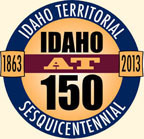 The San Francisco Evening Bulletin received a story, dated June 6, 1863, from “Our Own Correspondent” in Portland for publication in the newspaper. He began, “All the world knows that during this summer there has been a very lively steamboat opposition between here and Lewiston, and the points intermediate.”
The San Francisco Evening Bulletin received a story, dated June 6, 1863, from “Our Own Correspondent” in Portland for publication in the newspaper. He began, “All the world knows that during this summer there has been a very lively steamboat opposition between here and Lewiston, and the points intermediate.”The correspondent did not sign himself as “Rover,” the one who had submitted items from Lewiston to the Bulletin on April 12 and May 24. But Rover had, indeed, made a point of mentioning t...
Published on June 06, 2013 00:30
Weiser Stockman and Irrigation Developer Thomas Galloway [otd 06/06]
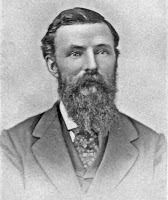 Tom Galloway. Illustrated History.Weiser pioneer Thomas C. Galloway was born June 6, 1837 in Iowa County, Wisconsin. He was a teenager when the family emigrated along the Oregon Trail to Yamhill County, Oregon in 1852. Tom pursued a variety of jobs, including some time as a teacher, before leading pack trains into the British Canadian gold fields.
Tom Galloway. Illustrated History.Weiser pioneer Thomas C. Galloway was born June 6, 1837 in Iowa County, Wisconsin. He was a teenager when the family emigrated along the Oregon Trail to Yamhill County, Oregon in 1852. Tom pursued a variety of jobs, including some time as a teacher, before leading pack trains into the British Canadian gold fields. In 1863, Galloway packed supplies into the Boise Basin, then stayed to work in the gold fields. The following year, he and Woodson Jeffreys settled...
Published on June 06, 2013 00:04
June 5, 2013
U. S. Army Shifts More Troops into Idaho Territory
 On June 5, 1863, The Oregonian reported on activities in Walla Walla, Washington: “Major Truax has been ordered to Lapwai – probably to take command of the post there. It is thought that Col. Steinberger will be returned to the command of Fort Walla Walla.”
On June 5, 1863, The Oregonian reported on activities in Walla Walla, Washington: “Major Truax has been ordered to Lapwai – probably to take command of the post there. It is thought that Col. Steinberger will be returned to the command of Fort Walla Walla.”Sewall Truax was born in 1830, in southern Quebec, Canada to parents who were U. S. citizens. He grew up near Saint Albans, Vermont, perhaps 20-30 miles south of where he was born. Educated as an engineer at Norwich University in Vermont, h...
Published on June 05, 2013 00:30
Eleven Dead, Millions in Damages Due to Teton Dam Failure [otd 06/05]
On the morning of Saturday, June 5, 1976, observers noticed a major leak in the north abutment of the Teton Dam. This came after two days of increasing seepage. Within about three hours, a whirlpool in the reservoir behind the structure signaled that a substantial flow was undermining the dam.
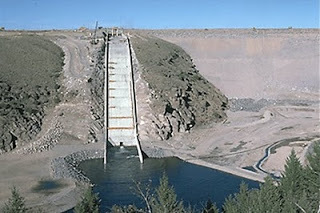 Spillway of intact dam. U.S. Bureau of Reclamation.
Spillway of intact dam. U.S. Bureau of Reclamation.
Located on the Teton River 13-14 miles northeast of Rexburg, Idaho, the structure was the culmination of over forty years of speculation, and then plann...
 Spillway of intact dam. U.S. Bureau of Reclamation.
Spillway of intact dam. U.S. Bureau of Reclamation.Located on the Teton River 13-14 miles northeast of Rexburg, Idaho, the structure was the culmination of over forty years of speculation, and then plann...
Published on June 05, 2013 00:09
June 4, 2013
Pettigrew Amendment Clarifies Forest Reserves Management [otd 06/04]
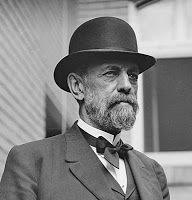 Senator Pettigrew. Library of Congress.On June 4, 1897, President William McKinley signed a "Sundry Civil Appropriations" bill, which included an amendment crucial to the development of our national forests.
Senator Pettigrew. Library of Congress.On June 4, 1897, President William McKinley signed a "Sundry Civil Appropriations" bill, which included an amendment crucial to the development of our national forests.The "Pettigrew Amendment" – for South Dakota Senator Richard F. Pettigrew – addressed issues that had rendered previous forest legislation "ineffectual and annoying."
Initially, the Federal government saw the public lands as simply a source of revenue. The General Land Office sold them off...
Published on June 04, 2013 00:05
June 3, 2013
General Connor, Soda Springs, and Franklin, Idaho
 On June 3, 1863, a correspondent for the Evening Bulletin in San Francisco wrote an article after arriving in Salt Lake City. He had traveled with General Patrick Connor’s Army column into Idaho Territory and back. As noted for April 29, Connor had established a military post near Soda Springs, as well as a Morrisite settlement there.
On June 3, 1863, a correspondent for the Evening Bulletin in San Francisco wrote an article after arriving in Salt Lake City. He had traveled with General Patrick Connor’s Army column into Idaho Territory and back. As noted for April 29, Connor had established a military post near Soda Springs, as well as a Morrisite settlement there.Leaving a company of California Volunteer infantry as garrison, Connor had then marched south along the Bear River. The correspondent said, “Proceeding southward...
Published on June 03, 2013 00:30
Army Doctor M. W. Wood and Spotted Fever Research [otd 06/03]
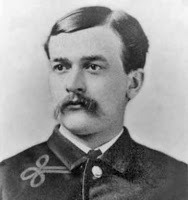 Marshall Wood. U. S. Army archives.Lieutenant Colonel Marshall William Wood, Army Medical Corps, was born June 3, 1846, in Watertown, New York, about sixty miles north of Syracuse. He enlisted as an Army Private in late 1864 and was twice wounded in Civil War action.
Marshall Wood. U. S. Army archives.Lieutenant Colonel Marshall William Wood, Army Medical Corps, was born June 3, 1846, in Watertown, New York, about sixty miles north of Syracuse. He enlisted as an Army Private in late 1864 and was twice wounded in Civil War action.After his discharge in the summer of 1865, Wood found a position as a medical assistant at a retired solders home in Milwaukee, Wisconsin. There, he began his medical studies in a physician’s office.
In 1870, he re-enlisted in the...
Published on June 03, 2013 00:05
June 2, 2013
Boise Replaces Volunteer Fire Department with Professional Firefighters [otd 06/02]
On June 2, 1902, Boise’s volunteer fire crew disbanded and fire protection became the responsibility of the new professional Boise Fire Department.
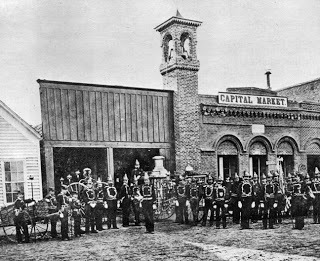 Early Boise Fire Station. Boise Fire Dept.
Early Boise Fire Station. Boise Fire Dept.
Boise City “survived” without an organized fire brigade for quite a long time, considering the threat. As in every other early town, pioneers built almost all their structures out of wooden logs and rough-sawn lumber. It was not like they did not see the risk. They knew that Idaho City had almost been wipe...
 Early Boise Fire Station. Boise Fire Dept.
Early Boise Fire Station. Boise Fire Dept.Boise City “survived” without an organized fire brigade for quite a long time, considering the threat. As in every other early town, pioneers built almost all their structures out of wooden logs and rough-sawn lumber. It was not like they did not see the risk. They knew that Idaho City had almost been wipe...
Published on June 02, 2013 00:06
June 1, 2013
High Wages in the Mines of Idaho
 The June 1, 1863 issue of the New York Post published a brief item: “Laborers’ wages in Idaho territory are eight dollars per day.”
The June 1, 1863 issue of the New York Post published a brief item: “Laborers’ wages in Idaho territory are eight dollars per day.”At that time, non-farm laborers in the East earned less than $1.50 a day. Farm laborers did well to make 50¢ a day, although they usually got meals as part of the deal. One can easily see why men might be tempted to head for the gold fields. Of course, those wages seemed much less generous when common food items, like bacon and bread, might cost four to ten times...
Published on June 01, 2013 00:30
Water Starts Flowing Through Egin Bench Irrigation Canal [otd 06/01]
On June 1, 1883, water flowed from a pioneer canal onto Egin Bench farmland. The Bench bends for about 12-14 miles along the west side of Henry’s Fork, some 25 to 35 miles north of today’s Idaho Falls.
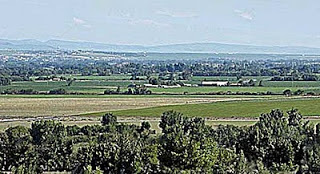 Egin Bench farmland near Henry’s Fork.
Egin Bench farmland near Henry’s Fork.
The first settlers arrived on the bench during the summer of 1879, shortly after Utah & Northern Railway tracks reached Eagle Rock (today’s Idaho Falls). While they saw potential there, they had to be content at first with cutting hay and raising stock....
 Egin Bench farmland near Henry’s Fork.
Egin Bench farmland near Henry’s Fork.The first settlers arrived on the bench during the summer of 1879, shortly after Utah & Northern Railway tracks reached Eagle Rock (today’s Idaho Falls). While they saw potential there, they had to be content at first with cutting hay and raising stock....
Published on June 01, 2013 00:09
South Fork and More
As an author's vehicle, this blog will include my thoughts on the writing process, supplemental information about my books, and "status"updates on current projects.
My long-time blog -- the South Fork As an author's vehicle, this blog will include my thoughts on the writing process, supplemental information about my books, and "status"updates on current projects.
My long-time blog -- the South Fork Companion -- leans heavily toward Idaho history. In particular, I post an "On This Day" (OTD) item with an Idaho "spin" for every day of the year. I originally tried to have the system bring over the entire item, but the transfer does not handle the photo captions well. That's not good, because I generally include two images with each of my OTD posts. ...more
My long-time blog -- the South Fork As an author's vehicle, this blog will include my thoughts on the writing process, supplemental information about my books, and "status"updates on current projects.
My long-time blog -- the South Fork Companion -- leans heavily toward Idaho history. In particular, I post an "On This Day" (OTD) item with an Idaho "spin" for every day of the year. I originally tried to have the system bring over the entire item, but the transfer does not handle the photo captions well. That's not good, because I generally include two images with each of my OTD posts. ...more
- Evan E. Filby's profile
- 2 followers



